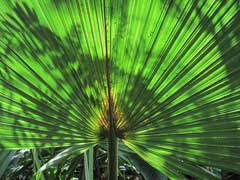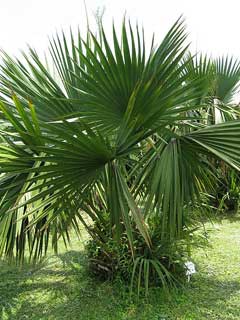 |
|
http://commons.wikimedia.org/wiki/User:Jean-Pol_GRANDMONT |
 |
| http://commons.wikimedia.org/wiki/User:KENPEI |
Translate this page:
Summary
Bloom Color: White. Main Bloom Time: Early spring, Late spring, Mid spring. Form: Palm, Upright or erect.
Physical Characteristics

 Sabal_minor is an evergreen Shrub growing to 3 m (9ft) by 2 m (6ft) at a slow rate.
Sabal_minor is an evergreen Shrub growing to 3 m (9ft) by 2 m (6ft) at a slow rate.
See above for USDA hardiness. It is hardy to UK zone 8. It is in leaf all year. The species is hermaphrodite (has both male and female organs) and is pollinated by Bees.
Suitable for: light (sandy), medium (loamy) and heavy (clay) soils and prefers well-drained soil. Suitable pH: mildly acid, neutral and basic (mildly alkaline) soils. It cannot grow in the shade. It prefers moist soil. The plant can tolerate maritime exposure.
UK Hardiness Map
US Hardiness Map
Synonyms
S. adansonii.
Plant Habitats
Edible Uses
Fresh root slices have been baked and eaten as bread[257]. The fruit is a small dry berry up to 10mm in diameter, with a thin sweet flesh[229]. Although we have seen no other records of edibility for this species, the following uses are for the related S. palmetto. They quite probably also apply here[K]. Fruit - raw or cooked[2]. Sweet and pleasant[2]. A small dry berry up to 12mm in diameter, with a thin sweet flesh[229]. A nourishing food, though it is said to be an acquired taste[2]. Young leaves - raw or cooked[171]. An excellent food[2]. The large succulent leaf buds are cooked and eaten as a vegetable[82]. Sap - sweet[2].
References More on Edible Uses
Medicinal Uses
Plants For A Future can not take any responsibility for any adverse effects from the use of plants. Always seek advice from a professional before using a plant medicinally.
The crushed, small root juice has been rubbed into sore eyes as a counterirritant[257]. A decoction of the dried root has been taken in the treatment of high blood pressure and kidney problems[257].
References More on Medicinal Uses
The Bookshop: Edible Plant Books
Our Latest books on Perennial Plants For Food Forests and Permaculture Gardens in paperback or digital formats.

Edible Tropical Plants
Food Forest Plants for Hotter Conditions: 250+ Plants For Tropical Food Forests & Permaculture Gardens.
More

Edible Temperate Plants
Plants for Your Food Forest: 500 Plants for Temperate Food Forests & Permaculture Gardens.
More

More Books
PFAF have eight books available in paperback and digital formats. Browse the shop for more information.
Shop Now
Other Uses
The dried leaves are used occasionally for the thatched roofs of huts[229]. The following reports are for S. palmetto. They quite probably also apply to this species[K]. An excellent fibre is obtained from the leaf stalks[171]. The best quality is from young leaf stalks still in the bud, whilst coarser material is obtained from older leaves or the bases of old leaf stalks surrounding the bud[171]. The fibres are up to 50cm long, they are harvested commercially and used to make brushes, especially where these have to remain stiff in hot water or caustics[82, 171]. Pieces of the spongy bark of the stem are used as a substitute for scrubbing brushes[82]. The leaves are woven to make coarse hats, mats and baskets[82]. The roots contain about 10% tannin[171]. This has been harvested commercially in the past but there is not really enough tannin for profitable extraction[171]. Wood - light and soft[82]. The trunks are used to make wharf piles, whilst polished cross-sections of the trunk have been used as small table tops[82]. The wood is also largely manufactured into canes[82].
Special Uses
References More on Other Uses
Cultivation details
Landscape Uses:Border, Container, Erosion control, Ground cover, Massing, Seashore, Specimen. Succeeds in most fertile moist but well-drained soils in a sheltered sunny position[188, 200, 231]. Although it prefers a humid atmosphere, this species is tolerant of arid atmospheres so long as it has plenty of moisture available at the roots[231]. This palm tolerates short-lived freezes down to about -10°c and can be grown outdoors in the very mildest areas of the country[231]. Sabal minor is usually a small palm with a subterranean trunk; however, one can find individuals with larger features and well-developed aerial stems. In Louisiana, these individuals were recognized as separate species, but more recently they have been treated as merely ecological variants of a single widespread species[270]. Large emergent forms of S. minor were even thought to be hybrids of that species with S. palmetto, but this claim is undocumented and unsubstantiated[270]. Palms usually have deep penetrating root systems and generally establish best when planted out at a young stage. However, older plants are substantially more cold tolerant than juvenile plants[231]. In areas at the limit of their cold tolerance, therefore, it is prudent to grow the plants in containers for some years, giving them winter protection, and only planting them into their permanent positions when sheer size dictates[231]. This species can also be transplanted even when very large. Although the thick fleshy roots are easily damaged and/or desiccated, new roots are generally freely produced. It is important to stake the plant very firmly to prevent rock, and also to give it plenty of water until re-established - removing many of the leaves can also help[231]. Of prolific growth and vigour in its native environment, this species has proved to be difficult to establish and slow to grow in cultivation[231]. Small plants are especially slow to get away and are best container-grown until of a god size[231]. Special Features:North American native, Fragrant flowers, Attractive flowers or blooms.
References Carbon Farming Information and Carbon Sequestration Information
Temperature Converter
Type a value in the Celsius field to convert the value to Fahrenheit:
Fahrenheit:
The PFAF Bookshop
Plants For A Future have a number of books available in paperback and digital form. Book titles include Edible Plants, Edible Perennials, Edible Trees,Edible Shrubs, Woodland Gardening, and Temperate Food Forest Plants. Our new book is Food Forest Plants For Hotter Conditions (Tropical and Sub-Tropical).
Shop Now
Plant Propagation
Seed - best sown as soon as it is ripe in a warm greenhouse at not less than 24°c[188]. Stored seed is very slow to germinate. Pre-soaking the seed for 24 hours in warm water prior to sowing may shorten the germination time. Plants form a long tap-root some time before forming a shoot. Germination of fresh seed usually takes place in 3 - 4 months at 25°c[138]. As soon as they are large enough to handle, prick the seedlings out into individual pots and grow them on in the greenhouse for at least their first two winters. Plant them out into their permanent positions in late spring or early summer, after the last expected frosts. Consider giving them some protection from the cold for at least their first winter outdoors.
Other Names
If available other names are mentioned here
Native Range
NORTHERN AMERICA: United States (Oklahoma, Alabama, Arkansas, Florida, Georgia, Louisiana, Mississippi, North Carolina (southeast), South Carolina, Texas).
Weed Potential
Right plant wrong place. We are currently updating this section.
Please note that a plant may be invasive in one area but may not in your area so it's worth checking.
Conservation Status
IUCN Red List of Threatened Plants Status :

Growth: S = slow M = medium F = fast. Soil: L = light (sandy) M = medium H = heavy (clay). pH: A = acid N = neutral B = basic (alkaline). Shade: F = full shade S = semi-shade N = no shade. Moisture: D = dry M = Moist We = wet Wa = water.
Now available:
Food Forest Plants for Mediterranean Conditions
350+ Perennial Plants For Mediterranean and Drier Food Forests and Permaculture Gardens.
[Paperback and eBook]
This is the third in Plants For A Future's series of plant guides for food forests tailored to
specific climate zones. Following volumes on temperate and tropical ecosystems, this book focuses
on species suited to Mediterranean conditions—regions with hot, dry summers and cool, wet winters,
often facing the added challenge of climate change.
Read More
Expert comment
Author
(Jacq.)Pers.
Botanical References
200229274
Links / References
For a list of references used on this page please go here
Readers comment
| Add a comment |
|
If you have important information about this plant that may help other users please add a comment or link below. Only comments or links that are felt to be directly relevant to a plant will be included. If you think a comment/link or information contained on this page is inaccurate or misleading we would welcome your feedback at [email protected]. If you have questions about a plant please use the Forum on this website as we do not have the resources to answer questions ourselves.
* Please note: the comments by website users are not necessarily those held by PFAF and may give misleading or inaccurate information.
To leave a comment please Register or login here All comments need to be approved so will not appear immediately.
|
|